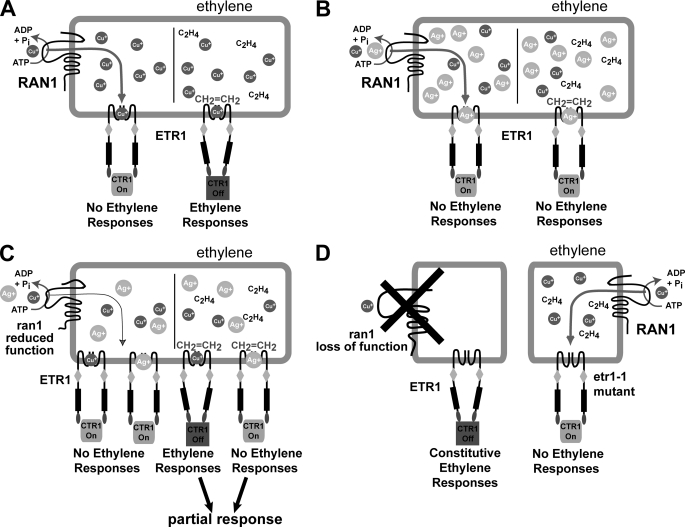FIGURE 6.
Model for the function of RAN1 in ethylene receptor biogenesis and function. In this model, RAN1 and the ethylene receptors are presumed to be co-localized in the same membrane system, at least transiently, during receptor biogenesis. A, left, in the absence of ethylene, the receptors are active and function to activate CTR1. This in turn inhibits downstream signaling. Right, ethylene inhibits the receptors by binding to copper in the binding site, leading to decreased CTR1 activity and the release of inhibition to downstream components. When both RAN1 and ETR1 are expressed normally, copper is delivered to the receptor, and normal biogenesis occurs, leading to a normally functioning receptor that binds ethylene and undergoes the required conformational change to turn off. B, in the presence of silver, RAN1 delivers both silver and copper to the receptors but in such a ratio that most contain silver. In this situation, ethylene binds to the silver ion, but the binding event is not transduced through the receptor, and the receptor remains on. C, in the reduced-function ran mutants (ran1-1 and ran1-2), fewer ions are transported to the receptors. When silver is added in this situation, we predict that the population of copper-containing and silver-containing receptors is shifted, so more contain copper, and a partial response to ethylene occurs. D, left, in the ran1 loss-of-function mutants (ran1-3 and ran1-4), little or no copper is transported to the receptors and abnormal biogenesis occurs, resulting in receptors that are permanently turned off. This leads to a constitutive ethylene phenotype. Right, in contrast, the etr1-1 mutant cannot coordinate the copper ion. Therefore, even though RAN1 transports copper to the receptor, it cannot incorporate the ion. However, unlike the wild-type receptors lacking copper in ran1 loss-of-function mutants, the etr1-1 receptor is locked in the signaling state, leading to ethylene-insensitive plants.

